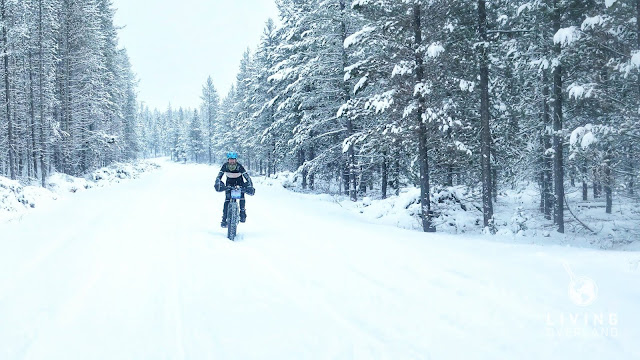Fat Biking: The Solution to Recreating Through the Winter and Year-Round
 |
| Photo: Jamye Chrisman Photography |
Winter is upon us. Do you have a plan for staying active and breathing in the crisp air this season? There are plenty of options for winter recreation. Fat biking, riding with 3.8" or wider tires, is becoming an increasingly popular way to enjoy the outdoors, no matter the time of year. They are predominantly thought to be ridden in snow, however, they thrive in sandy, loose and chunky conditions as well.
Why Fat Bikes?
 From the work commuter to the casual mountain biker to the bikepacker to the ultra-endurance winter racer, the fat bike is inarguably the one bike that can be ridden anywhere and everywhere, providing a year-round solution to exploring the outdoors.
From the work commuter to the casual mountain biker to the bikepacker to the ultra-endurance winter racer, the fat bike is inarguably the one bike that can be ridden anywhere and everywhere, providing a year-round solution to exploring the outdoors.There is a preconceived notion that fat bikes are slow, however, in the conditions in which they thrive, there is no other bike for the job. This ability of not being restricted by terrain or weather allows the fat bike to be extremely versatile.
 |
| Derrick Nobman catching air at the Saint Anthony Sand Dunes. |
The Gear You Need To Get Started
So you plan to get a fat bike. The first question you need to consider is when and where are you going to be riding? Is this strictly a winter bike or do you plan to ride year round? Do you intend to do any bikepacking or touring on it? What kind of terrain will you be riding?Accessories
What you need is largely dependent on where and how you are riding. But if you will be doing any fat biking in cold weather, having some bags to carry gear and additional layers will do you good. The triangle frame bag is the best use of space real estate on the bike. Use it for a water bladder, food, an extra layer, your toolkit... the list goes on.
The triangle frame bag is the best use of space real estate on the bike. Use it for a water bladder, food, an extra layer, your toolkit... the list goes on.A seat pack functions great for extra layers on days with fluctuating temperatures and weather.
With these bags you can forgo a backpack, keeping the weight off your back and allowing it to breath better.
Handlebar "feed bags" are great for stashing snacks, water bottles, or any personal items such as a phone, camera or sunglasses.
Pro Tip: Store the insulated water bottles upside down in the handlebar feed bags for even more insulation and freeze-prevention.
 Fat biking in the winter is just like any other winter sport – layering wisely is crucial. Thinner and less bulky is better. This allows for movement, breathability, and packability when you remove it.
Fat biking in the winter is just like any other winter sport – layering wisely is crucial. Thinner and less bulky is better. This allows for movement, breathability, and packability when you remove it.Boots with 200 grams of insulation are ideal for most winter riding. There are specific clipless cycling boots, but winter hiking boots also work well if you are using flat pedals. Gaiters are useful as well if the snow is deep and you need to put a foot down or walk.
Where To Ride
Snowmobile trails are a great place to fat bike. Many of them are groomed by non-profits or public land managers. If you're using these trails, it's good to purchase a sticker permit to support the grooming efforts. This also shows snowmobilers that you care about access and aren't just taking advantage of the free trails they like to use.
Some Nordic ski tracks allow fat biking, but it is important to understand proper trail etiquette.
Community and Events
This is a great way to discover more places to ride and connect with fellow fat bike and winter enthusiasts. Talk to your bike shop and find out about the local events you can participate in.Guidelines and Etiquette
- Wildlife: Understand you're in their home. Bikes are quieter than we think and moving quickly – make yourself known.
- Trail Etiquette: riding soft or freshly groomed trails will leave behind a rut that ruins the trail, negates the grooming efforts and can cause your fellow trail users to catch a tire or ski and wreck.
- Be aware of other trail users like snowshoers, cross-country skiers, and other fat bikers. Cyclists yield to everyone.
- Pick up after yourself and your pets. Obey trail rules and boundaries.
Conclusion
The most important thing to remember is to have fun and get out there, even when you feel like not riding.
Aaron Couch is a wildlife advocate, writer, and an enthusiast of all things human-powered. Based in Teton Valley, Idaho, he runs an adventure website, Destination Reroute encouraging others to step out of their comfort zones and seek adventure. When he isn't writing or at the bike shop, look closely up into the mountains and you just might see him skirting a sidehill on his bike.








